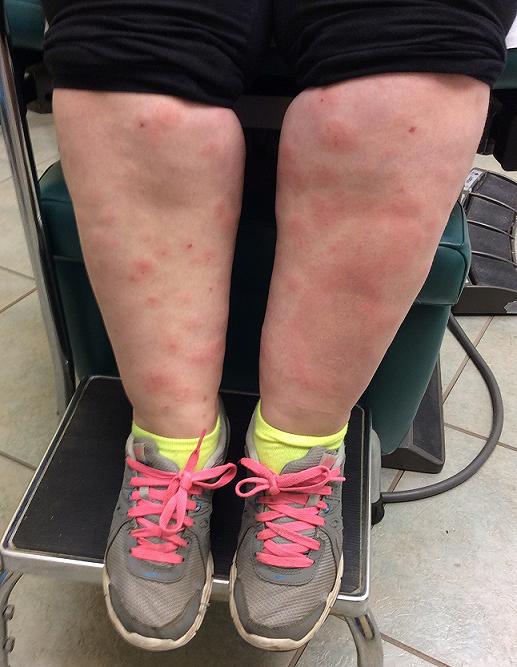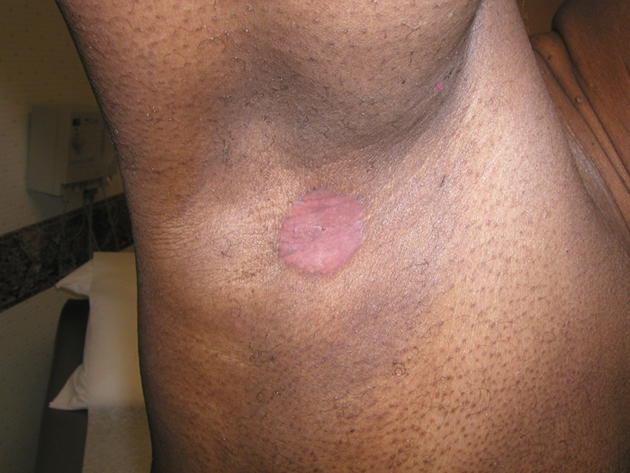CORRECT DIAGNOSIS:
Erythema Nodosum
DISCUSSION:
Erythema nodosum (EN) is septal panniculitis that most often occurs in women, 20-40 years of age. Clinically, there are red to purple subcutaneous, often painful, nodules symmetrically distributed on the bilateral shins. Lesions have also been noted to occur on the thighs, buttocks, extensors, and face. 16 to 72 percent of EN cases are idiopathic. The most common identifiable cause is a recent Streptococcal infection. Other conditions associated with EN include infectious etiologies such as tuberculosis, histoplasmosis, coccidioidomycosis, etc. Erythema induratum is a nodular vasculitis that can present similarly though often occurring on posterior calves with overlying ulcerations and concomitant tuberculosis infection should be considered. The most common drug to cause EN is oral contraceptives. EN has also been found to occur in pregnancy. For individuals with symptoms of respiratory distress and findings of hilar adenopathy on imaging, sarcoidosis should be considered in the differential.
In addition, inflammatory bowel disease and Behcet’s disease also are common causes of EN. It is important to do a thorough review of systems and full skin examination to identify these entities. Complete laboratory workup includes complete blood count, anti-streptolysin titer or throat culture, and erythrocyte sedimentation rate. Furthermore, tuberculin skin testing and chest x-ray can be considered in at-risk populations. It is important to obtain an adequate specimen for histopathologic diagnosis. Ideally, a deep incisional biopsy with adequate adipose tissue is recommended. Erythema nodosum is a self-limited condition that typically resolves in 6-8 weeks. Supportive treatment including rest, compression, and elevation are important alleviating measures. NSAIDS such as aspirin, indomethacin, and naproxen can help with symptoms of tenderness. For more resistant cases, colchicine or potassium iodide may be used. Patients may need further treatment depending on the underlying cause.
TREATMENT:
Our patient was instructed to elevate legs and use OTC Motrin for pain. On follow up, many lesions had already resolved with some remnant post-inflammatory hyperpigmentation.
REFERENCES:
Cribier, B., Caille, A., Heid, E., & Grosshans, E. (1998). Erythema nodosum and associated diseases: A study of 129 cases. International Journal of Dermatology, 37, 667. https://doi.org/10.1111/j.1365-4362.1998.tb03658.x
Gilchrist, H., & Patterson, J. W. (2010). Erythema nodosum and erythema induratum (nodular vasculitis): Diagnosis and management. Dermatologic Therapy, 23(4), 320-327. https://doi.org/10.1111/j.1529-8019.2010.01325.x
Gonzalez-Gay, M. A., Garcia-Porrua, C., Pujol, R. M., & Salvarani, C. (2001). Erythema nodosum: A clinical approach. Clinical and Experimental Rheumatology, 19, 365.
Requena, L., & Sanchez Yus, E. (2007). Erythema nodosum. Seminars in Cutaneous Medicine and Surgery, 26(2), 114-125. https://doi.org/10.1016/j.sder.2007.05.001
Soderstrom, R. M., & Krull, E. A. (1978). Erythema nodosum: A review. Cutis, 21, 806.




